Newsagent – Newsstand Business Plan
People’s News is a new chain of newsagent kiosks in Chinatown, New York City. Launching in 2010, the business will open subway station newsstands selling English and Chinese periodicals, along with drinks and snacks for both markets. Customers include Chinatown residents, commuters, visitors, and tourists. Chinatown is a shopping and tourism destination for out-of-towners and NYC residents. People’s News aims to introduce mainland China periodicals and products to customers while promoting American publications to Chinese immigrants and English-speaking customers. The business is owned and managed by Hui Kao and his son, Zhi Kao.
Products sold at People’s News kiosk locations include Chinese magazines, newspapers, Chinese-American magazines, newspapers, and American magazines and newspapers. They will also offer refrigerated beverages, snacks, and candy. Newspapers will be available daily and weekly, while magazines will be weekly and monthly.
Although the business will have a small loss in its first year, positive cash flows in the second and third years will be used to expand to three stores within three years. This expansion will provide steady income for Hui and Zhi Kao, as well as two additional relatives or employees. Once three stores are operational, revenue is expected to exceed $700,000 per year.
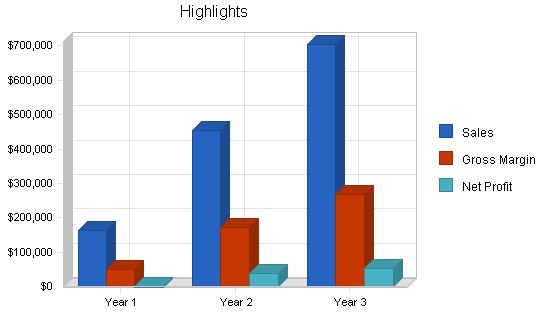
Contents
Objectives
People’s News aims to achieve the following objectives within the first three years:
- Establish three store locations
- Provide full-time employment for four individuals (preferably members of the owner’s family)
- Reach annual revenues of $700,000
Mission
The mission of People’s News is to build a loyal customer base by selling American and Chinese newspapers, magazines, snacks, and drinks to residents and visitors of Chinatown, New York City. The company strives to remain family-owned and managed, employing as many family members as possible and creating stable incomes for them. The business aims to increase cultural awareness by offering a wider range of American products and periodicals to Chinese-American residents and providing non-Chinese customers with recommendations on Chinese and Chinese-American products and periodicals.
Keys to Success
Keys to success for the newsstand business include:
Choosing highly-trafficked locations for stands
Offering desirable snacks, beverages, and reading material for travelers using subway or bus
Obtaining better prices from suppliers through greater volume and centralized purchasing
Ensuring all employees are bilingual or trilingual (at least English and Mandarin, ideally English, Mandarin, and Cantonese)
Company Summary
People’s News is a new chain of newsagent kiosks in Chinatown, New York City. The business will open subway station newsstands selling both English and Chinese language periodicals, as well as drinks and snacks suitable for both markets. The target customers are Chinatown residents, commuters, visitors, and tourists. Chinatown attracts shoppers and tourists from other neighborhoods in New York City. People’s News, named after the People’s Republic of China, aims to offer mainland China periodicals and products to customers while also introducing American publications to Chinese immigrants to promote cultural and language exposure and better serve English-speaking customers.
Company Ownership
People’s News will be owned and managed by Hui Kao, a former shop owner in China. It will operate as a limited liability partnership with Hui Kao owning 80% of the business and his 22-year-old son, Zhi Kao, owning 20%. Hui Kao plans to transfer his ownership stake to his son, daughter, or wife upon retirement or death. The business will be primarily operated by its owners to ensure a steady income through wages and dividends.
Start-up Summary
The start-up costs for People’s News are minimal. The first store location will ideally be an abandoned kiosk previously used by another tenant. People’s News will collaborate with the New York Metropolitan Transit Authority to find a suitable location in Chinatown. The desired location should be at least 75 square feet and situated within a subway station. Legal advice will be obtained at a low cost through assistance from a local Chinese-American nonprofit. Monthly installments will cover insurance for liability and business owner’s insurance to protect against any liability to employees, customers, and property. An estimated $500 will be allocated for renovations to improve the stand’s appearance by performing basic repairs and refinishing and repainting.
Based on research conducted on other newsagent businesses, the monthly rent for the kiosk is estimated to be $500, and one month’s rent must be paid before launch to allow for setup and renovation. The required permits and licenses include incorporation, a Department of Consumer Affairs license, Community Board permit, and Department of Transportation license.
The start-up assets include cash to cover operating losses in the early months, a basic start-up inventory of $1,000 (including $350 for monthly periodicals, $350 for weekly periodicals, $100 for snacks, $100 for drinks, and $100 for candy), current assets ($500 security deposit on space), and long-term assets ($500 for a refrigerator, $200 for food/snack displays, $200 for periodical racks, $300 for a cash register, and $200 for other miscellaneous items).

Start-up Requirements:
– Legal Advice: $500
– Insurance: $200
– Renovations: $500
– Store Rent: $500
– Permits and Licenses: $2,000
– Total Start-up Expenses: $3,700
Start-up Assets:
– Cash Required: $10,000
– Start-up Inventory: $1,000
– Other Current Assets: $500
– Long-term Assets: $1,400
– Total Assets: $12,900
Total Requirements: $16,600
Products:
People’s News will sell the following products at its kiosk locations:
– Chinese magazines and newspapers (Beijing Daily, China Daily, China Youth Daily, People’s Daily, China Press, Caijing magazine and two dozen more)
– Chinese-American magazines and newspapers (approximately a dozen titles)
– American magazines and newspapers (NY Times, Daily News, New York Post, People, Entertainment Weekly, and dozens more)
– Refrigerated Beverages (sodas, juices, energy drinks, iced teas, etc.)
– Snacks (bags of chips, pretzels, Fritos, Chinese crispy snacks, etc.)
– Candy (chocolate bars, gums, breath fresheners, Chinese candy, etc.)
Newspapers will be both daily and weekly, and magazines will be weekly and monthly. Publications and product deliveries will be dropped off directly to the primary kiosk location and distributed by employees to other locations, when they are added, to earn better prices from suppliers.
Where possible, multiple products or periodicals will be purchased from the same supplier to decrease the overall number of suppliers. However, there will be a focus on providing a reasonable level of product diversity, at least on par with other newsagents/newsstands. People’s News cannot offer the same diversity of offerings as a magazine or news store with 100 square feet or more of space but will offer extreme convenience due to its locations on subway platforms.
Market Analysis Summary:
The market for People’s News products is broken into a few separate groups, each with their own needs:
– Non-English speaking Chinese-American residents of Chinatown
– English speaking Chinese-American residents of Chinatown
– Chinese and Chinese-American tourists from elsewhere
– Other English speaking tourists from outside of New York City
– New York City residents shopping in Chinatown
– New York City commuters passing through or changing trains in Chinatown
The type of customers cannot be influenced by People’s News beyond its selection of location. The business will rely 100% on serving the type of customers who use the subway lines out of Chinatown. These six groups are the primary market segments People’s News will serve.
Market Segmentation:
The market’s six groups are estimated based on Census data, NYC tourism data, and NYC commuter data. These groups are all growing, but Chinese tourism to the US and Chinese immigration to NYC is increasing faster than the other segments due to growing openness between the nations.
The following are descriptions of the specific needs of each segment as they relate to People’s News:
– Non-English speaking Chinese-American residents of Chinatown: Desire Chinese-language periodicals (Mandarin and Cantonese at least) that they are familiar with. As they attempt to learn English, many begin to read English-language publications as well.
– English speaking Chinese-American residents of Chinatown: Desire Chinese-language, Chinese-American, and English-language periodicals.
– Chinese and Chinese-American tourists from elsewhere: Desire Chinese and Chinese-American snacks, and sometimes periodicals. They pass through the subways on their way to see tourist destinations and are less likely to be reading magazines and newspapers while in New York.
– Other English speaking tourists from outside of New York City: Also will purchase snacks and drinks more commonly. They may want to sample Chinese products when in Chinatown rather than products they can purchase at a newsagent anywhere.
– New York City residents shopping in Chinatown: Potential to buy English-language periodicals and snacks/beverages when they arrive or leave Chinatown from shopping trips.
– New York City commuters passing through or changing trains in Chinatown: Potential to buy English-language periodicals and snacks/beverages when they pass through Chinatown subway stations. This group is larger but with a lower likelihood of buying if they are merely changing trains.
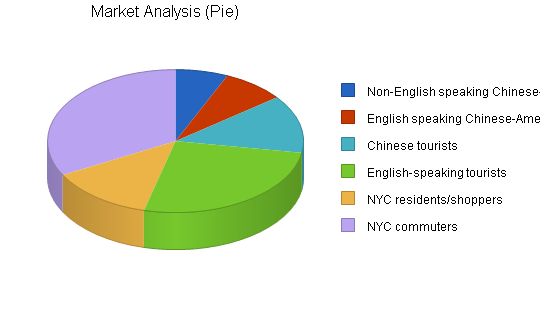
Market Analysis
| Market Analysis | |||||||
| Year 1 | Year 2 | Year 3 | Year 4 | Year 5 | |||
| Potential Customers | Growth | CAGR | |||||
| Non-English speaking Chinese-American residents | 5% | 50,000 | 52,500 | 55,125 | 57,881 | 60,775 | 5.00% |
| English speaking Chinese-American residents | 2% | 60,000 | 61,200 | 62,424 | 63,672 | 64,945 | 2.00% |
| Chinese tourists | 5% | 100,000 | 105,000 | 110,250 | 115,763 | 121,551 | 5.00% |
| English-speaking tourists | 3% | 200,000 | 206,000 | 212,180 | 218,545 | 225,101 | 3.00% |
| NYC residents/shoppers | 3% | 100,000 | 103,000 | 106,090 | 109,273 | 112,551 | 3.00% |
| NYC commuters | 2% | 250,000 | 255,000 | 260,100 | 265,302 | 270,608 | 2.00% |
| Total | 3.00% | 760,000 | 782,700 | 806,169 | 830,436 | 855,531 | 3.00% |
Target Market Segment Strategy
The market segmentation is based on the belief that a customer’s purchases at a newsstand are related to what brought them there. Tourists look for "authentic" products, while commuters and shoppers value items they can use on their subway rides. Residents of Chinatown seek news and magazines daily for education and entertainment. To serve all these groups, People’s News will provide English, Mandarin, and Cantonese language periodicals.
Answers.com provides key information on the newsstand and news dealer industry:
– 1997 Census showed 2,313 establishments with $853 million in sales and 9,770 people employed.
– The average annual revenue per location is $369,000.
– Outdoor news dealers may close in winter due to lack of insulation.
– Larger chains and franchises are increasing.
– The industry has been declining due to online and TV news.
Competition and Buying Patterns
Direct competition for newsagent kiosks comes from convenience stores, grocery stores, mass-market bookstores, magazine stores, street newspaper salespeople, and specialty stores. Indirect competition comes from subscriptions, television news, internet news, and radio.
The primary advantage a subway-location newsstand offers is convenience. Other stores offer a wider range of products, but shopping time is increased. Street newspaper salespeople offer convenience but limited choice. People’s News counters competition by offering food and drinks, enticing customers to make impulse purchases.
For those who buy on impulse, brand names are not important. The products are trusted regardless of the store name.
Strategy and Implementation Summary
People’s News aims to serve residents, commuters, shoppers, and tourists in Chinatown subway stations. To target these customers, People’s News will:
– Offer products familiar to both Chinese speakers and English speakers.
– Hire bilingual clerks.
– Expand to three stores to share resources, increase negotiating power, and build brand recognition.
Competitive Edge
People’s News provides a unique advantage by focusing on both Chinese-speaking and English-speaking customers. This strategy sets it apart from newsagents in Chinatown that only sell products familiar to Chinese immigrants or American newsstands that offer the same products as any other newsstand in the city. Additionally, the exclusive subway kiosk location provides an advantage that is hard to imitate.
People’s News will primarily rely on foot traffic for sales, utilizing low-cost marketing tactics such as informing friends and family about the business and posting signs in English, Cantonese, and Mandarin to create brand recognition. Pricing will be consistent with other newsstands.
Sales Strategy
The sales strategy for People’s News is based on location, bilingual salespeople, and providing swift and friendly service. Bilingual staff members ensure comfortable interaction with Chinese or English-speaking customers.
By serving customers quickly and remaining friendly, People’s News aims to stay at the top of customers’ minds.
Sales consist of monthly magazines, weekly magazines and newspapers, daily newspapers, and beverages, snacks, and candy. The business will start with one location in the first year and double sales in the second year with a second location. The addition of a third location in the third year will lead to further revenue growth.
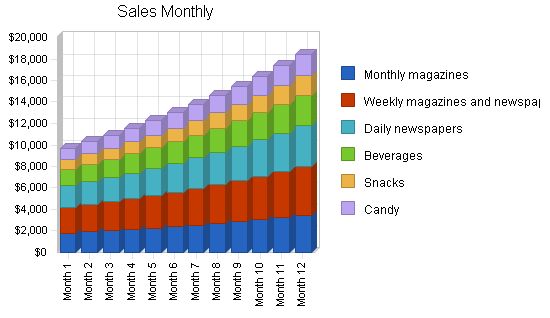
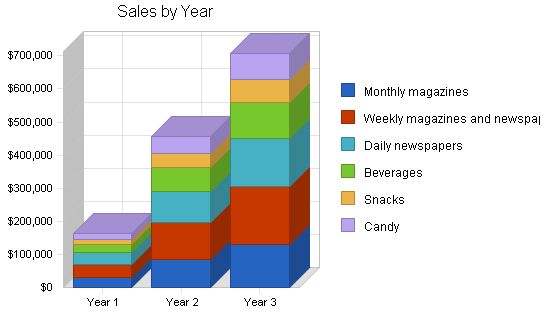
Sales Forecast
| Sales Forecast | |||
| Year 1 | Year 2 | Year 3 | |
| Unit Sales | |||
| Monthly magazines | 10,122 | 28,156 | 43,641 |
| Weekly magazines and newspapers | 20,244 | 56,311 | 87,282 |
| Daily newspapers | 33,740 | 93,852 | 145,470 |
| Beverages | 20,244 | 56,311 | 87,282 |
| Snacks | 16,026 | 44,580 | 69,098 |
| Candy | 23,618 | 65,696 | 101,829 |
| Total Unit Sales | 123,994 | 344,906 | 534,604 |
Milestones
Hui Kao will manage the lease, license, and permit process. He will delegate the renovation of the store and purchasing of initial inventory to his son, Zhi Kao. Additional stores will be launched after one and two years pass. These costs are all represented within startup costs and the three-year cash flow statement.
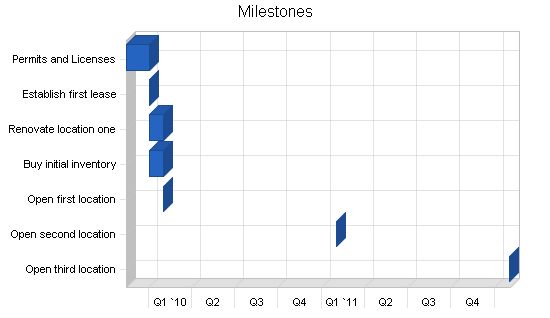
Milestones:
– Permits and Licenses: 11/15/2009 – 1/1/2010, $1,000 budget, Manager: Hui Kao, Department: Hui Kao
– Establish first lease: 1/1/2010 – 1/1/2010, $1,000 budget, Manager: Hui Kao, Department: Hui Kao
– Renovate location one: 1/1/2010 – 1/31/2010, $500 budget, Manager: Hui Kao, Department: Zhi Kao
– Buy initial inventory: 1/1/2010 – 1/31/2010, $1,000 budget, Manager: Hui Kao, Department: Zhi Kao
– Open first location: 2/1/2010 – 2/1/2010, $1,400 budget, Manager: Hui Kao, Department: Hui Kao
– Open second location: 2/1/2011 – 2/1/2011, $2,400 budget, Manager: Hui Kao, Department: Hui Kao
– Open third location: 2/1/2012 – 2/1/2012, $2,400 budget, Manager: Hui Kao, Department: Hui Kao
– Totals: $9,700 budget
Management Summary:
Hui Kao will be the CEO and Administrative Manager. He will split sales clerk work at the first store with his son, Zhi Kao. Zhi Kao will be an administrative assistant, handling inventory purchasing, location renovation, and maintenance. Hui Kao will dedicate 50% of his time to administration and supervision in the second year and 75% in the third year, reducing his store work to 50% and then 25% of his time.
Hui Kao will manage accounts payable and bookkeeping, while bank deposits will be made by Hui Kao or Zhi Kao. Zhi Kao will distribute deliveries between the locations after they arrive at the first store.
Zhi Kao will receive mentorship as a manager-in-training during the first three years and will eventually be able to manage all business operations in Hui Kao’s absence. Zhi Kao is expected to become the CEO of the business when Hui retires.
Hui Kao owned and operated a small grocery store in China for fifteen years, where he also sold periodicals. Zhi Kao worked in the store for five years as a teenager, gaining experience in sales and some management tasks.
Personnel Plan:
Initially, there will be one full-time equivalent employee, consisting of Hui Kao and Zhi Kao working part-time at the first store. Both Hui and Zhi Kao will handle administrative work during the startup phase. In the second and third years, additional part-time workers will be hired for each store. Hui Kao will spend time between the three stores and provide centralized services starting from the third year, for which he will receive a salary.
Health insurance will not be provided at the business’s launch, but it will be offered to full-time employees in the second year. The cost of insurance is already included in the personnel costs listed here. It is expected that three full-time employees will receive health insurance.
Personnel Plan:
– Store 1 Employees:
– Year 1: $36,000
– Year 2: $41,400
– Year 3: $42,642
– Store 2 Employees:
– Year 1: $0
– Year 2: $41,400
– Year 3: $42,642
– Store 3 Employees:
– Year 1: $0
– Year 2: $0
– Year 3: $42,642
– Administrative Manager:
– Year 1: $0
– Year 2: $0
– Year 3: $10,000
– Total People: Year 1: 1, Year 2: 3, Year 3: 4
Total Payroll: Year 1: $36,000, Year 2: $82,800, Year 3: $137,926
Hello!
I’m Andrew Brooks, a seasoned finance consultant from the USA and the mind behind phonenumber247.com.
My career is built on a foundation of helping individuals and businesses thrive financially in an ever-changing economic landscape. At phonenumber247.com, my aim is to demystify the complex world of finance, providing clear, actionable advice that can help you navigate your financial journey with confidence. Whether it’s personal finance management, investment strategies, or understanding the nuances of market dynamics, I’m here to share insights and tools that can propel you towards your financial goals.
Welcome to my digital space, where every piece of advice is a step closer to financial clarity and success!
